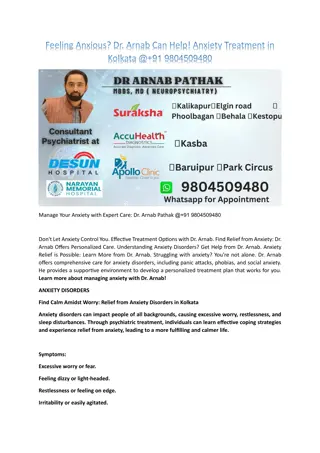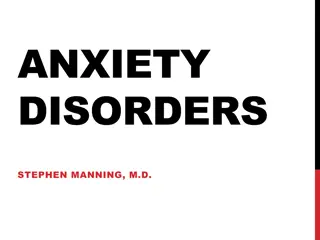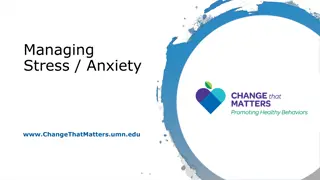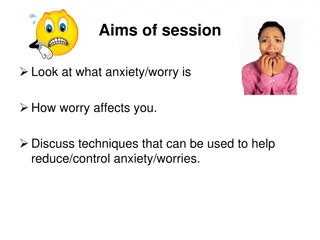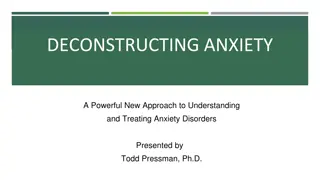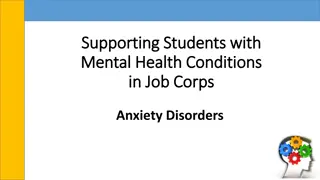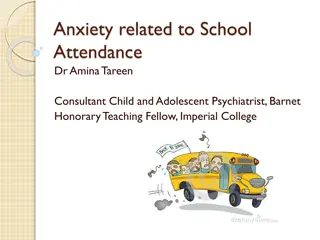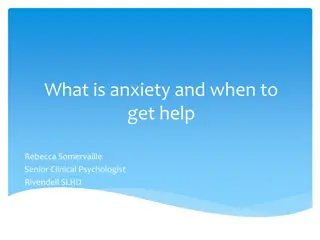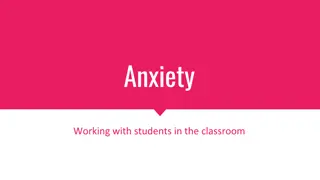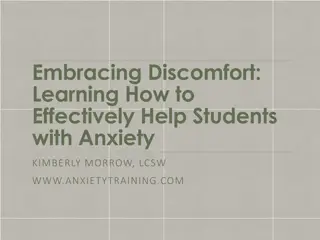Understanding Anxiety Disorders and Related Conditions
Explore the distinguishing features of anxiety disorders such as generalized anxiety disorder, panic disorder, and phobias, along with insights into obsessive-compulsive disorder (OCD) and posttraumatic stress disorder (PTSD). Delve into the impact of conditioning, cognition, and biology on these conditions to gain a comprehensive understanding of the factors contributing to feelings and thoughts associated with anxiety disorders. Engage with concepts such as social anxiety disorder, the differences between anxiety and anxiety disorders, and the symptoms and diagnostic considerations for various anxiety-related conditions.
Download Presentation

Please find below an Image/Link to download the presentation.
The content on the website is provided AS IS for your information and personal use only. It may not be sold, licensed, or shared on other websites without obtaining consent from the author. Download presentation by click this link. If you encounter any issues during the download, it is possible that the publisher has removed the file from their server.
E N D
Presentation Transcript
Learning Targets 66-1 Contrast generalized anxiety disorder, panic disorder, and phobias. Module 66 66-2 Describe obsessive-compulsive disorder (OCD). Anxiety Disorders, Obsessive Compulsive Disorder and Posttraumatic Stress Disorder 66-3 Describe posttraumatic stress disorder (PTSD). 66-4 Examine how conditioning, cognition, and biology contribute to the feelings and thoughts that mark anxiety disorders, OCD, and PTSD.
What are anxiety disorders? psychological disorders characterized by distressing, persistent anxiety or maladaptive behaviors that reduce anxiety Four anxiety disorders will be covered in this Module: Social anxiety disorder Generalized anxiety disorder Panic disorder Phobia and agoraphobia
Anxiety or anxiety disorder? Have you felt anxiety? What events, people, situations, etc., cause you to feel anxious? What do you think makes anxiety different from an anxiety disorder? Talk about your thoughts with a classmate.
What is social anxiety disorder? People with social anxiety disorder become extremely anxious in social settings where others might judge them, such as parties, class presentations, or even eating in public. intense fear and avoidance of social situations (formerly called social phobia) To stave off anxious thoughts and feelings (including physical symptoms such as sweating and trembling), they may avoid going out at all.
1. What Would You Answer? Rebekah has grown increasingly nervous about going to school and social gatherings. When she is assigned a presentation in English class, she is so terrified that her teacher and classmates will judge her harshly that she can t bring herself to go to school at all. A therapist would be most likely to diagnose her with A. ADHD. B. panic disorder. C. obsessive-compulsive disorder. D. social anxiety disorder. E. posttraumatic stress disorder.
What is generalized anxiety disorder? Out-of-control, agitated feelings suggest generalized anxiety disorder, which is marked by excessive and uncontrollable worry that persists for six months or more. People with this condition (2/3 are women) worry continually, and they are often jittery, agitated, and sleep- deprived. (McLean & Anderson, 2009) an anxiety disorder in which a person is continually tense, apprehensive, and in a state of autonomic nervous system arousal
What are some characteristics of generalized anxiety disorder? The person usually cannot identify, and therefore relieve or avoid, the tension s cause. To use Sigmund Freud s term, the anxiety is free-floating (not linked to a specific stressor or threat). Generalized anxiety disorder is often accompanied by depressed mood, but even without depression it tends to be disabling. (Hunt et al., 2004; Moffitt et al., 2007) Moreover, it may lead to physical problems, such as high blood pressure, sleep disturbances and other issues.
What is panic disorder? For the 3% of people with panic disorder, panic attacks are recurrent. These anxiety tornados strike suddenly, wreak havoc, and disappear, but are not forgotten. an anxiety disorder marked by unpredictable, minutes-long episodes of intense dread panic attacks- in which a person may experience terror and accompanying chest pain, choking, or other frightening sensations; often followed by worry over a possible next attack
What does a panic attack feel like? Golfer Charlie Beljan experienced what he later learned were panic attacks during an important tournament. His thumping heartbeat and shortness of breath led him to think he was having a heart attack.
overcoming panic Hospital tests revealed that Beljan s symptoms were not related to a physical illness. He recovered, went on to win $846,000, and has become an inspiration to others.
How can panic attacks lead to agoraphobia? After several panic attacks, people may avoid situations where panic might strike. If their fear is intense enough, people may develop agoraphobia fear or avoidance of public situations from which escape might be difficult. Given such fear, people may avoid being outside the home, in a crowd, or in an elevator.
What is a phobia? an anxiety disorder marked by a persistent, irrational fear and avoidance of a specific object, activity, or situation
What are you afraid of? Think of the fears you have. Talk them over with your class. What differentiates a fear from a phobia? Discuss your thoughts.
What are specific phobias? Specific phobias may focus on animals, insects, heights, blood, or close spaces.
Interpreting graphs. How common are the various specific phobias? Are more people afraid of enclosed spaces or phobic of water?
2. What Would You Answer? Andrew is so afraid of spiders that he is having a hard time leaving his spider-proofed home and going to work. Andrew s psychiatrist has diagnosed him with A. agoraphobia. B. a phobia. C. panic disorder. D. generalized anxiety disorder. E. posttraumatic stress disorder.
What is obsessive- compulsive disorder (OCD)? Obsessive thoughts are unwanted and so repetitive it may seem they will never go away. a disorder characterized by unwanted repetitive thoughts (obsessions), actions (compulsions), or both Compulsive behaviors are often responses to those thoughts.
What are some common obsessions and compulsions among those with OCD? Rituals and fussy behaviors cross the fine line between normality and disorder when they persistently interfere with everyday living and cause distress.
What is the difference between a normal behavior and one suggesting OCD? normal sign of disorder Checking 10 times that you locked the door is not. Checking that you locked the door is normal. Washing your hands so often that your skin becomes raw is not. Washing your hands thoroughly is normal. Organizing your markers and pens in rainbow order is normal. Not being able to use a pen unless it is in rainbow order is not.
Thriving with OCD. Music star Justin Timberlake has openly discussed his obsessive-compulsive disorder. He says that support from family and a rich sense of humor have helped him cope with the challenges.
What other disorders are classified as OCD- related disorders in the DSM-5? hoarding disorder (cluttering one s space with acquired possessions one can t let go) body dysmorphic disorder (preoccupation with perceived body defects) trichotillomania (hair-pulling) excoriation disorder (excessive skin-picking)
What is posttraumatic stress disorder (PTSD)? a disorder characterized by haunting memories, nightmares, hypervigilance, social withdrawal, jumpy anxiety, numbness of feeling, and/or insomnia that lingers for four weeks or more after a traumatic experience Typical symptoms include recurring haunting memories and nightmares, laser-focused attention to possible threats, social withdrawal, jumpy anxiety, and trouble sleeping. (Germain, 2013; Hoge et al., 2007; Yuval et al., 2017)
What treatment exists for PTSD? Many military war veterans participate in an intensive recovery program using deep breathing, massage, and group and individual discussion techniques to treat their PTSD.
Why do some develop PTSD after a traumatic event? About half of us will experience at least one traumatic event in our lifetime, yet 5 to 10% of people develop PTSD after a traumatic event and others don t. (Bonanno et al., 2011) One factor that might explain why some develop PTSD and others do not might be the amount of trauma-related emotional distress. The higher the distress, such as the level of physical torture suffered by prisoners of war, the greater the risk for posttraumatic symptoms. (King et al., 2015; Ozer et al., 2003)
What additional factors impact the development of PTSD in some people? Some people may have a more sensitive emotion- processing limbic system that floods their bodies with stress hormones, which explains why PTSD may coexist with another disorder. (Duncan et al., 2017; Kosslyn, 2005; Ozer & Weiss, 2004) Twins, compared with non-twin siblings, more commonly share PTSD cognitive risk factors. (Gilbertson et al., 2006) And the odds of experiencing PTSD after a traumatic event are about two times higher for women than for men. (Olff et al., 2007; Ozer & Weiss, 2004)
How does conditioning impact anxiety disorders, OCD, and PTSD? Anxious or traumatized people learn to associate their anxiety with certain cues. (Bar-Haim et al., 2007; Duits et al., 2015) 58% of those with social anxiety disorder developed the disorder following a traumatic event. (Ost & Hugdahl, 1981) Anxiety or an anxiety-related disorder is more likely to develop when bad events happen unpredictably and uncontrollably. (Field, 2006; Mineka & Oehlberg, 2008)
What is stimulus generalization? Remember from Module 26 that in classical conditioning, stimulus generalization is the tendency, once a response has been conditioned, for stimuli similar to the conditioned stimulus to elicit similar responses. In operant conditioning, stimulus generalization occurs when responses learned in one situation occur in other, similar situations.
How does stimulus generalization explain anxiety, OCD and PTSD? Stimulus generalization occurs when a person experiences a fearful event and later develops a fear of similar events. If a child is bit by a dog, the fear associated with that bite may develop into a fear of all dogs.
What is reinforcement and how does it help explain anxiety, OCD and PTSD? Recall from Module 27, in operant conditioning, reinforcement is any event that strengthens the behavior it follows. Reinforcement helps maintain learned fears and anxieties. Anything that enables us to avoid or escape a feared situation can reinforce maladaptive behaviors. Fearing a panic attack, we may decide not to leave the house. Reinforced by feeling calmer, we are likely to repeat that behavior in the future. (Antony et al., 1992) If washing our hands relieves our feelings of anxiety, we may wash our hands again when those feelings return.
How does cognition impact anxiety? Cognition, our thoughts, memories, interpretations, and expectations, influences our feelings of anxiety. Our past experiences shape our expectations and influence our interpretations and reactions. Whether we interpret the creaky sound simply as the wind or as a possible knife-wielding attacker determines whether we panic.
What research has been conducted on cognition and anxiety? Susan Mineka experimented with six monkeys raised in the wild (all strongly fearful of snakes) and their lab-raised offspring (virtually none of which feared snakes). After repeatedly observing their parents or peers refusing to reach for food in the presence of a snake, the younger monkeys developed a similar strong fear of snakes. When the monkeys were retested three months later, their learned fear persisted. (Mineka, 1985, 2002)
How do genes impact anxiety, OCD and PTSD? One research team identified 17 gene variations associated with typical anxiety disorder symptoms. (Hovatta et al., 2005) Other teams have found genes associated specifically with OCD. (Mattheisen et al., 2015; Taylor, 2013) If one identical twin has an anxiety disorder, the other is also at risk. (Polderman et al., 2015) Even when raised separately, identical twins may develop similar phobias. (Carey, 1990; Eckert et al., 1981)
How do genes regulate neurotransmitters that impact anxiety, OCD and PTSD? Some genes influence disorders by regulating brain levels of neurotransmitters. These include serotonin, which influences sleep, mood, and attending to threats. (Canli, 2008; Pergamin-Hight et al., 2012) Genes also regulate the levels of glutamate, which heightens activity in the brain s alarm centers. (Lafleur et al., 2006; Welch et al., 2007)
How do our experiences change our brain? Our experiences change our brain, paving new pathways. Traumatic fear-learning experiences can leave tracks in the brain, creating fear circuits within the amygdala (Etkin & Wager, 2007; Herringa et al., 2013; Kolassa & Elbert, 2007) These fear pathways create easy inroads for more fear experiences. (Armony et al., 1998)
How are brain structures involved? Brain scans of people with OCD reveal elevated activity in the anterior cingulate cortex during behaviors such as compulsive hand washing, checking, ordering, or hoarding. (Insel, 2010; Mataix-Cols et al., 2004, 2005)
What role does the anterior cingulate cortex play in OCD? The anterior cingulate cortex, a brain region that monitors our actions and checks for errors, seems especially likely to be hyperactive. (Maltby et al., 2005)
How does biology drive fears? The biological perspective helps us understand why most people have more fear of heights than does Alex Honnold, shown at right in 2017 becoming the first person to free solo climb (no safety ropes) Yosemite National Park s El Capitan granite wall.
How does natural selection underlie our fears? We seem biologically prepared to fear threats faced by our ancestors. Our phobias focus on specific fears such as spiders, snakes, and other animals; enclosed spaces and heights; storms and darkness. Those fearless about these occasional threats were less likely to survive and leave descendants. Even in Britain, with only one poisonous snake species, people often fear snakes.
Learning Target 66-1 Review Contrast generalized anxiety disorder, panic disorder, and phobias. Anxious feelings and behaviors are classified as an anxiety disorder when they form a pattern of distressing, persistent anxiety or maladaptive behaviors that reduce anxiety. People with generalized anxiety disorder feel persistently and uncontrollably tense and apprehensive for no apparent reason.
Learning Target 66-1 Review cont. Contrast generalized anxiety disorder, panic disorder, and phobias. In the more extreme panic disorder, anxiety escalates into periodic episodes of intense dread. Those with a phobia may be irrationally afraid of a specific object, activity, or situation.
Learning Target 66-2 Review Describe obsessive-compulsive disorder (OCD). Persistent and repetitive thoughts (obsessions) and behaviors (compulsions) characterize obsessive- compulsive disorder (OCD).
Learning Target 66-3 Review Describe posttraumatic stress disorder (PTSD). Symptoms of posttraumatic stress disorder (PTSD) include haunting memories, nightmares, social withdrawal, jumpy anxiety, and sleep problems following some traumatic experience.
Learning Target 66-4 Review Examine how conditioning contributes to the feelings and thoughts that mark anxiety disorders, OCD, and PTSD. Through conditioning, anxious or traumatized people may learn to associate their anxiety with certain cues. Stimulus generalization occurs when someone experiences a fearful event and later develops a fear of similar events. Reinforcement helps maintain learned fears and anxieties.
Learning Target 66-4 Review part II Examine how cognition contributes to the feelings and thoughts that mark anxiety disorders, OCD, and PTSD. Cognition can influence our expectations and our interpretation of and reaction to stimuli. We may learn some fears by observing others fears. People with anxiety disorders tend to be hypervigilant and attend more to threatening stimuli, more often interpret ambiguous stimuli as threatening, and remember threatening events.
Learning Target 66-4 Review part III Examine how biology contributes to the feelings and thoughts that mark anxiety disorders, OCD, and PTSD. Our biology also plays a role. Genetic predispositions for high levels of emotional reactivity and neurotransmitter production make us vulnerable to disorder, as do epigenetic marks. Abnormal responses in the brain s fear circuits can create inroads for disorder. Natural selection and evolution have prepared us to fear the threats our ancestors faced.



